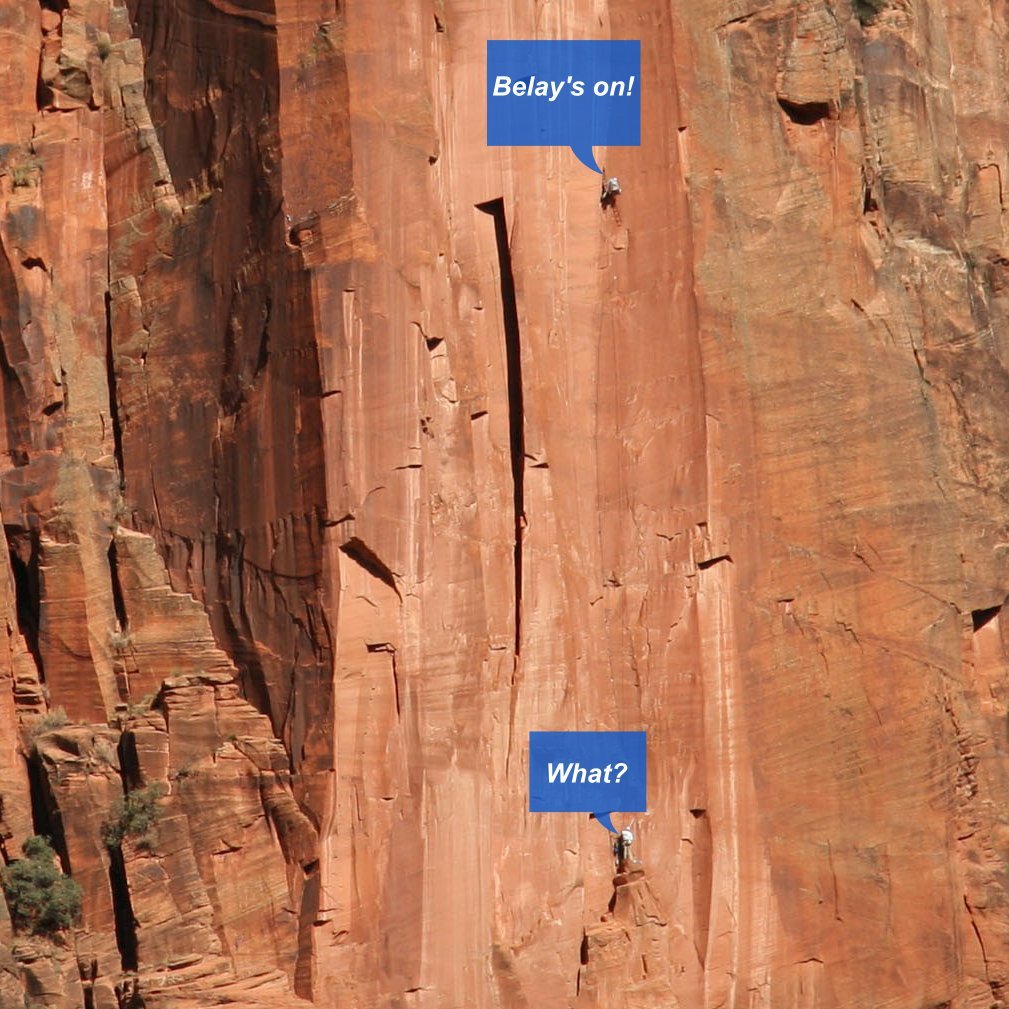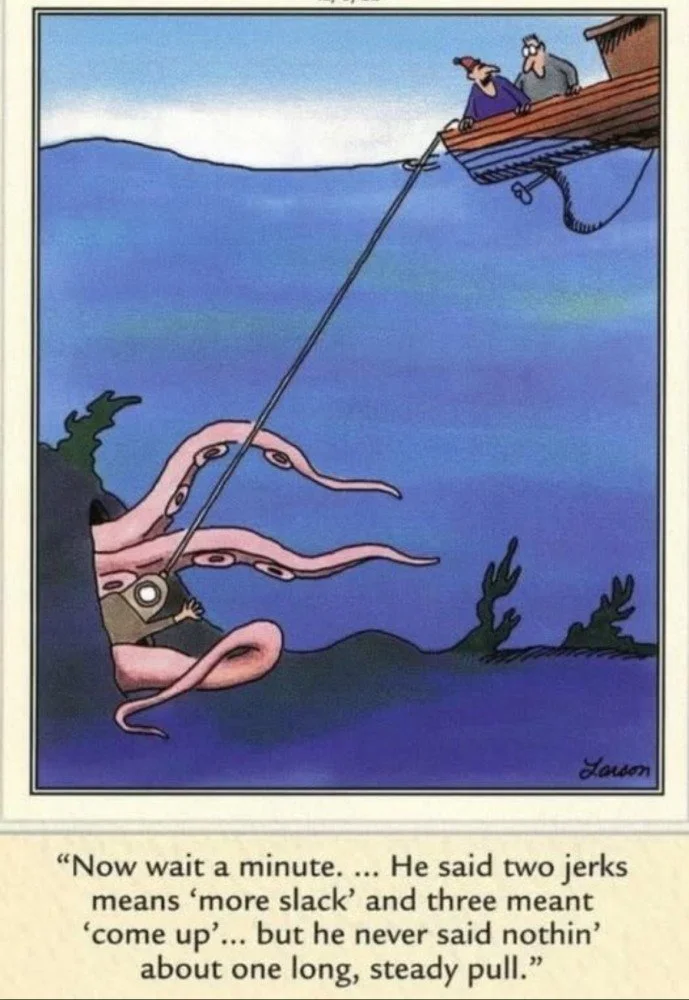Belay communication - the “silent system”
The fictional example of Maria and Jorge (shared here with permission) is from Derek DeBruin, and originally appeared in the American Alpine Club blog as part of a longer article on belay communication. Derek is an AMGA Certified Rock Guide and Assistant Alpine Guide. Connect with Derek: Facebook and Instagram.
Note - This post discusses techniques and methods used in vertical rope work. If you do them wrong, you could die. Always practice vertical rope techniques under the supervision of a qualified instructor, and ideally in a progression: from flat ground, to staircase, to vertical close to the ground before you ever try them in a real climbing situation.
Big wall climbing: excellent place for a good communication plan. Moonlight Buttress, Zion National Park. Utah USA. Me (belay) and my pal Gent Mende (leading)
Photo: Chau Phan Mende
What would you do in this scenario?
You and your partner are on a multi pitch rock climb, at the belay at the start of the second pitch. The pitch is fairly easy climbing, but it’s close to a full rope length, and goes around a corner with the next belay out of sight. In addition, the wind is picking up.
Your partner heads out on lead. After about 10 minutes of climbing the rope comes to a stop. You think you hear a faint call from your partner above, but you can’t make out the words. You of course continue to keep your partner on belay. The rope doesn’t move for a few more minutes. You think this probably means your partner has built an anchor, but you’re not sure, so you continue to keep the belay on.
Suddenly, the rope starts to move up quickly. You feed it through your device as fast as you can until it goes tight on your harness. About a minute later you feel some hard pulls on the rope.
“Huh,” you think, “what ‘da heck is this?” A few more minutes go by. The rope doesn’t move, you don’t hear any verbal calls from your partner.
So there you are, in what has become an uncertain and stressful situation: you don’t know if you’re on belay, and you also don’t know if your partner still needs your belay! This is a MESS in which many climbers will find themselves someday! Obviously, the simple verbal calls you learned on your first day climbing are not working in this situation.
Fortunately, there are several solutions. Let's have a closer look at a good one, the so-called “silent system”.
Here’s the core idea: if you can’t communicate verbally, the second simply keeps feeding rope until the rope is tight on their harness. They wait a minute or so, and then start to climb. Agree on this system before you need to use it!
Here's an example written by AMGA Rock Guide Derek DeBruin (shared with permission), with the fictional Maria and Jorge on a multi-pitch climb.
“Maria reaches the top of the pitch and secures herself to the anchor. Because they suspected the possibility of poor communication, Jorge and Maria agreed in advance to use only the necessary formal verbal commands. As Maria is secured to the anchor, she shouts, “Off belay!”
Unfortunately, Jorge is unable to hear this command. However, he knows that there are only two reasons that he might need to feed rope to the leader. Either Maria is still leading, or she has arrived at the belay stance and is pulling up excess rope. Since Jorge is unsure which is the case, he simply continues belaying until he reaches his end of the rope. As he did not hear Maria issue the “off belay” command, he has no reason to affirm this command. Instead, he skips this and simply proceeds to the next command, “Maria, that’s me!” He then removes his belay device from the rope. (The device is no longer needed because the rope is tight on his harness.)
Maria has pulled the rope until it is tensioned and thinks she hears Jorge shout a command to her, but she’s not positive. Regardless, her next step is clear: put Jorge on belay. She does so promptly and shouts, “On Belay!”
Meanwhile, down below, Jorge is diligently waiting to climb. Prior to starting the climb, Maria and Jorge agreed to a 30 second waiting period. After shouting, “Maria, that’s me!” Jorge waits 30 seconds and then removes himself from the anchor to begin climbing. He does this knowing that Maria will promptly put him on belay after the rope is tensioned, a task that should take no more than 30 seconds. Jorge and Maria could have agreed to any amount of time they felt appropriate; again the prior agreement is the important thing.
After the agreed upon amount of time, Jorge bellows, “Climbing!” and makes a couple moves. He has one last chance to make sure that he is on some form of belay. He’s making sure the rope is travelling up, in the characteristic progression of a belay cycle. In this sequence, Jorge and Maria have accepted that it might also be possible that Maria is not actually belaying. It is possible that she is still leading, and the team is now accidentally simul-climbing. Even though this may be scary and hopefully avoidable, Jorge and Maria understand that Jorge will have to climb in that scenario, even if he’s not on belay. What choice does he have?
Meanwhile, back at the top of the pitch, Maria cannot hear Jorge, but she can feel the slack in the rope he generates by climbing. She pulls the rope through the belay system and after a few feet of movement is sure Jorge must be climbing. As a confirmation, she yells, “Climb on!”
Notes . . .
Talk about this method with your partner BEFORE you think you might need it. Partners need to be in agreement. A 10 second discussion can save you from a very stressful and potentially dangerous communication breakdown.
One option for the leader is to put the second on belay with an plaquette style device BEFORE pulling up the slack rope. This is going to be a bit inconvenient if there is a lot of rope at the top, and it's not standard practice. But it does add a little extra insurance, and allows the second to start climbing pretty much the moment the rope goes tight on them. Again, a factor to agree on before you need it!
Have a close look at the route topo; what does the next pitch look like? Consider wind speed, pitch length and/or route going out of sight. Any one of these can make it impossible to hear a verbal belay call; two or more of these factors and you're more likely to have difficulties.
As the belayer, you need to watch for clues of what’s happening above. One, if you know the rope has gone out for the approximate known length of the pitch, and you notice that the rope has stopped moving for a few minutes, you can be pretty darn sure that your partner is in the process of building an anchor. If, after this pause, the rope quickly starts to be pulled up, your Sherlock Skills should deduce that the leader is pulling up slack, and you are about to be put on belay. You can be even more certain of this if you know the pitch length; if you know the pitch is 40 meters, and the leader has pulled up 60 meters of rope until it’s tight on you, you can be 99% sure they are at the anchor and are just about to put you on belay. Keep an eye on the middle mark of the rope, and use that to help estimate how much rope is out. (This assumes bolted anchors. For alpine climbing when you're building your own gear anchors, this guideline may not apply.)
Be cautious linking pitches. It seems trendy in some circles to link pitches together, especially if you're itching to use that new 80 meter rope you just got. However, linking pitches has several downsides. In addition to increased rope drag, having to carry a bigger rack, and maybe not having all the gear you need, another big problem is increasing the likelihood of the usual verbal commands not working. If you are going to link pitches or run out the rope, be sure to agree on a backup communication plan. (Might be a good time for a 2 way radio, more on that below)
Improved verbal calls. Verbal comms can work even in a challenging environment. A few tips:
Yell LOUDLY and direct your voice downward to your partner, not outward.
In alpine climbing, you can often choose where to build your anchor. Consider using shorter pitches to be sure you’re heard.
If possible, extend your clove hitch tether to the anchor a bit, which may let you lean around the corner and perhaps have line of sight with your partner.
What about rappelling?
A silent way to signal “off rappel” is for rappeller to grab both rope strands and pull them back-and-forth through the anchor. This does a couple of things. 1) It’s a clear and obvious symbol that they are off rappel, and 2) it does a sort of “test pull” of the ropes and can show the remaining person up top where there might be a snag so they can hopefully deal with it..
The one downside to this method is that it doesn’t work if the top person has pre-rigged their rappel. Like climbing, and in life, pros and cons to just about everything.
Other options . . .
Rope pull signals
As the saying goes, they work great, until they don't. Rope pull signals can work quite well in favorable conditions, like relatively little rope drag, the pitch goes more or less in a straight line, there aren't cracks or protrusions where the rope might get hung up, etc.
Some folks try out a system that initially sounds pretty clever, with different numbers of pulls meaning different things. However, if you pull four times but your partner down below only feels two or three, which may have a completely different meaning, then the potential for serious miscommunication should be obvious. Avoid any system like this.
The pull signal that I used for a long time is this: Once the leader arrives at the anchor, they do the following:
Build an anchor
Put the second on belay
Pull up slack rope (Yes, usually, you pull up slack first, and THEN put your partner on belay, but this method is slightly lower risk.)
Pull on the rope as hard as you can five or six times. If your partner below only feels just two or three pulls, that’s the signal they need to start climbing.
Most of the time this works well, but I’ve had it not work a few times when there was lots of rope drag. I think the “silent system” is better.
image: Gary Larson, The Far Side
Radios
For a more technical solution, short-range FRS radios are increasingly popular. Some newer models have beefier construction, better electronics, and are a big improvement over the ones you may have used long ago.
However, radios come with their own problems, such as high cost, batteries that can die, one extra thing to remember to bring along and take care of, and sometimes a hassle to carry on your harness. In some scenarios, such as with multiple partners, very long pitches, ski touring or big wall climbing, they can definitely be useful. However, as a default solution, it's not my first choice.


